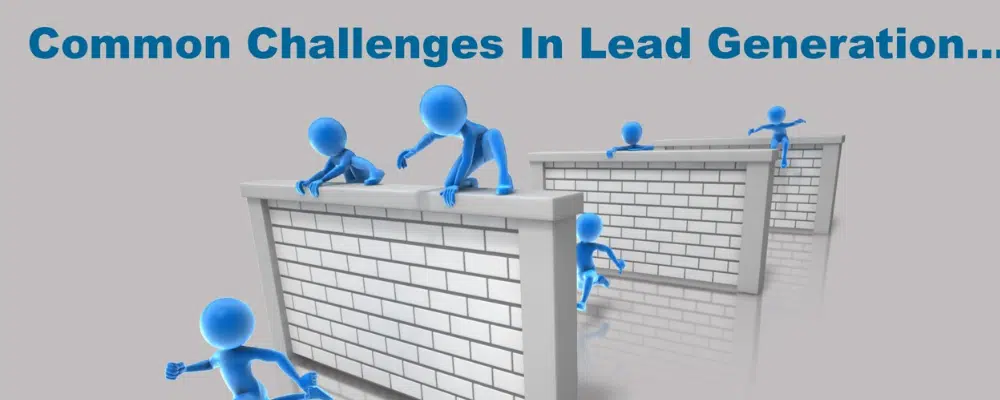The quest for growth and success remains an unceasing journey in the ever-evolving landscape of business and commerce. Like a river constantly seeking its course to the ocean, businesses are forever on the lookout for opportunities to expand their horizons. At the heart of this pursuit lies a fundamental challenge: how to find and attract the right customers who will not only engage with your brand but also become loyal patrons. This challenge, known as lead generation, is the lifeblood of any thriving enterprise.
Lead generation isn’t just a buzzword; it’s the essential foundation upon which businesses build their future. It’s the process of identifying and cultivating potential customers, nurturing their interest, and ultimately converting them into paying clients. In a world awash with information, reaching out to the right audience amidst the noise is akin to finding a needle in a haystack. Yet, mastering the art of lead generation can make the difference between a company’s stagnation and its meteoric rise.
This article serves as a roadmap for business leaders, marketers, and entrepreneurs seeking to navigate the treacherous waters of lead generation successfully. We will see the common pitfalls that hinder progress and, more importantly, illuminate the proven strategies and solutions that can guide you towards a bountiful harvest of leads. The insights in these pages will help you seize opportunities, overcome challenges, and ultimately thrive in the ever-competitive world of lead generation, regardless of your level of marketing experience.
A Guide to Understanding Lead Generation
What is lead generation? Well, lead generation is like fishing for potential customers. Getting in touch with people who might be interested in your products or services is the process of finding them. Imagine you have a store that sells cool gadgets, and you want to find people who are likely to buy them. Lead generation helps you find those potential buyers.
Now, why is lead generation so important? Think of it this way: without leads, it’s like having a fishing rod with no fish in sight. Leads are like the fish you want to catch. They are the lifeblood of any business because they can turn into customers. More leads mean more potential customers, which can lead to more sales and growth for your business.
Types of Leads
Cold Leads: These are people who haven’t shown much interest in your products or services yet. Your business might not even be known to them. It’s like they’re standing far away from your fishing spot, and you need to lure them in.
Warm Leads: Warm leads are a bit closer to becoming customers. They’ve shown some interest, like signing up for your newsletter or following your social media accounts. They’re getting closer to the fishing hook, but they’re not quite there yet.
Hot Leads: Hot leads are the ones you want to catch! These people are very interested in what you offer. They might have filled out a contact form, requested a demo, or even put items in their shopping cart. They’re right by the fishing hook, ready to be reeled in as customers.
Common Lead Generation Challenges
You want to find people who are genuinely interested in what you’re offering. These are the quality leads. But sometimes, it’s hard to figure out who they are among all the people out there. Identifying quality leads means finding those who are most likely to become paying customers.
Lead scoring is like giving points to each potential customer based on how interested they are. It’s a way to separate the good leads from the not-so-good ones. For example, someone who visits your website and signs up for your newsletter might get more points than someone who just looks at your homepage. Lead scoring helps you focus your efforts on the leads that are most likely to convert into customers.

Leads need nurturing to grow into customers. Nurturing means building a relationship with your potential customers over time. It’s important because not everyone is ready to buy right away. By nurturing them, you keep them interested until they are ready to make a purchase.
Sometimes, businesses make mistakes when nurturing leads. They might send too many emails too quickly or not provide helpful information. These mistakes can push potential customers away instead of bringing them closer. Effective lead nurturing involves providing valuable content and engaging with your leads in a way that feels helpful, not pushy.
High competition means there are lots of other businesses vying for the attention of the same potential customers. In order to thrive, it’s crucial to grasp your competition and devise a strategy to shine amidst the masses.
To stand out in a competitive market, you need a unique hook. To attract customers, your business needs to offer something unique. This could be exceptional customer service, a unique product feature, or a compelling marketing campaign. It’s about finding what makes your business different and using that to capture the attention of potential customers amidst all the competition.
Strategies for Successful Lead Generation
Creating a Buyer Persona
Imagine you’re throwing a birthday party, and you want to make sure your guests have a great time. To do that, you need to know their interests, preferences, and what makes them tick. In the world of business, this understanding is called creating a buyer persona. It’s like creating a detailed profile of your ideal customer. The more you know about them, the better you can tailor your marketing efforts to attract them. To create a buyer persona, you’ll need to gather data and insights about your target audience. This includes their demographics, behaviors, and pain points. Once you have this information, you can develop a persona that represents your typical customer. This persona becomes the guiding star for your marketing efforts, helping you connect with the right people.
Content Marketing
Think of content as your invitation to the party. It’s what draws people in and keeps them interested. In lead generation, content is your lead magnet. It can be in the form of blog posts, eBooks, videos, or any other valuable information that your target audience finds useful. When you provide valuable content, you attract potential customers who are interested in what you have to offer.
There are many types of content you can create to attract leads. Blogs are like friendly conversations with your audience, while eBooks offer in-depth knowledge. Videos bring your message to life. The key is to choose the type of content that resonates with your audience and aligns with your goals.
SEO and Keyword Optimization
Search engine optimization (SEO) is a process that helps improve the visibility of your online content. It aims to make your web pages more accessible to search engines like Google. When your content is well-optimized, it’s like having a clear road sign that guides search engines to your website. As a result, your content is more likely to appear higher in search results, increasing the chances of potential customers finding your business. Keywords are the clues search engines use to find your content. Keyword research tools help you identify the right keywords to target. These tools show you what words and phrases people are searching for online, helping you create content that aligns with their interests and needs.

Social Media Marketing
Social media is like a bustling marketplace where people gather to chat, share, and discover new things. It’s also a goldmine for lead generation. By being active on platforms like Facebook, Twitter, and Instagram, you can reach a wider audience and engage with potential customers in real-time. It’s like joining the party where your target audience hangs out. Social media isn’t just about posting content; it’s about interacting with your audience. Respond to comments, answer questions, and show the human side of your business. Building relationships on social media can turn followers into leads and leads into loyal customers.
Email Marketing
Email marketing is like sending them personalized invitations to your next event. Building an email list is crucial for lead generation. You can collect emails through your website, social media, or other marketing efforts. These emails become your direct line to potential customers. Once you have an email list, you can send targeted email campaigns. These campaigns can include newsletters, special offers, or educational content. The key is to provide value and nurture the relationship with your subscribers. Over time, some of them will become paying customers.
Pay-Per-Click Advertising
Pay-per-click (PPC) advertising is like paying for premium spots at a party where your ideal customers are hanging out. Google Ads and Facebook Ads allow you to display your ads to a specific audience. You only pay when someone clicks on your ad, making it a cost-effective way to reach potential leads. With PPC advertising, you can set a budget and target specific demographics, interests, and locations. This means you can ensure your ads are seen by the people most likely to become leads. It’s like choosing the perfect party location and inviting the right guests.
Overcoming Lead Generation Challenges
Quality Lead Generation Tools
CRM Systems: Customer Relationship Management (CRM) systems are essential tools for businesses. They function as centralized databases that store crucial information about leads and customers. Through a CRM, businesses can efficiently manage contact details, interactions, and preferences. This organized approach simplifies the process of identifying and nurturing quality leads.
Lead Generation Software: Lead generation software is like having a super-powered fishing net. It helps you find potential customers more efficiently. These tools can search the internet for people who fit your ideal customer profile and collect their contact information. It’s a time-saving way to gather leads and focus your efforts on the right prospects.
Lead Nurturing Automation
Marketing Automation Platforms: Marketing automation platforms are like efficient assistants for businesses. They enable the setup of automated processes to deliver emails, messages, or content to leads at scheduled intervals. This streamlines communication, saves time, and ensures that leads consistently receive relevant information.
Drip Campaigns: Drip campaigns are a method of sending a series of scheduled emails or messages to leads over a period. Each message is crafted to educate, engage, and guide the lead towards becoming a customer. Drip campaigns help maintain brand awareness and keep the lead engaged without inundating them with information.
Content Personalization
Tailoring Content to Leads: Content personalization is akin to tailoring marketing efforts to individual preferences. It entails creating customized content that directly addresses the unique interests and needs of each lead. By adapting messages and content to match a lead’s preferences, the likelihood of converting them into customers is heightened.

Dynamic Content: Dynamic content is like a chameleon that changes its appearance based on who’s looking at it. With dynamic content, you can display different messages, images, or offers to different leads based on their behavior or characteristics. This makes your marketing more relevant and engaging, increasing the likelihood of conversion.
Competitive Analysis
Monitoring Competitors: Competitive analysis involves monitoring your business competitors in the market. By observing their activities, you can gain insights into their strategies and identify potential opportunities they may have overlooked. It’s a way to stay ahead and remain competitive in the business world.
Adapting Strategies: Adapting strategies is similar to staying flexible in response to changing circumstances. By gathering information about competitors, businesses can adjust their lead generation tactics to distinguish themselves. This may involve offering unique solutions or addressing unmet needs in the market. The goal is to maintain agility and competitiveness in a dynamic business environment.
Conclusion
Lead generation is the lifeblood of business growth. It’s an ongoing journey that requires persistence and adaptability. By implementing the strategies discussed here, you equip your business with the tools to attract, nurture, and convert leads into loyal customers. Remember that the importance of lead generation never diminishes; it remains essential for sustained success. As you navigate this dynamic landscape, stay open to learning, adapt to changing customer preferences, and continually refine your strategies. Your commitment to lead generation will lead your business to new heights of growth and prosperity.




